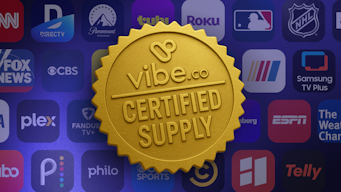How to test incrementality with Vibe x Haus
Incrementality testing is a mission-critical element of any brand's advertising strategy on streaming TV in 2025. In an era of budget scrutiny and measurement skepticism, knowing what's driving real, incremental impact is more important than ever before.
What is Incrementality and Why Does It Matter?
Incrementality measures how a change in strategy causes a change in business outcomes. For example, how many new customers converted from a streaming TV campaign who wouldn't have converted otherwise? Incrementality testing identifies the channels and tactics causing business outcomes, rather than just reporting on clicks, impressions, etc., so you can strategically allocate spend to what's driving the business.
If you're under-allocating the budget to CTV, you're not just missing reach—you're also inviting waste through duplication. You're paying to serve the same people ads across multiple screens while ignoring the growing swaths of viewers who have cut the cord, tuned out of linear, and now stream everything.
Said plainly, if you're not measuring incremental lift, you're flying blind. As media costs rise and attention spans shrink, duplicative reach is no longer just inefficient—it's reckless.
Walled gardens and probabilistic identity graphs may seem like they’re complicating attribution, but it never really existed. After all, clicks and views never answered the real question: did this tactic cause a behavior that wouldn’t have happened otherwise? That’s where incrementality comes in. It measures causality, not correlation.
Real-World Success: Haus + Vibe.co = Smarter CTV Investment
Haus, a leader in incrementality measurement, has made this model actionable at scale. Their platform automates incrementality testing across media partners and provides experiment results showing:
- Incremental reach
- Cost per incremental outcome
- iROAS, filtered through the lens of lift, not vanity metrics
But measurement alone isn’t enough. You need a media partner that makes it easy to launch, test, and optimize CTV campaigns across audiences, channels, and creative variants.
That’s where Vibe.co comes in.
Vibe.co is built for modern marketers—those who demand transparency, agility, and proof of performance. With seamless integration into Haus's measurement framework, we make it ridiculously simple to:
- Launch CTV campaigns in minutes, not weeks
- Automatically segment audiences for incrementality testing
- Optimize in real-time based on true incremental performance
- Adjust creative and targeting mid-flight, based on lift—not just reach
It’s the kind of agility brand and performance marketers crave, with the kind of rigor CFOs respect.
Together, Vibe and Haus empower marketers to not just spend smarter, but to prove it too. Every impression is accountable. Every outcome is measurable. And every campaign can confidently scale, backed by statistical certainty.
Measuring CTV Incrementality
1. Control vs. Treatment Groups
The gold standard in incrementality testing is the “the randomized control group,” which many incrementality platforms use, but there are key differences in how well the “randomizing” and the “controlling” happen. That’s where Haus truly shines.
A typical incrementality test starts with two audience groups—one exposed to your CTV ad (the treatment) and one held back (the control). Both groups are characteristically similar across every relevant dimension: demographics, behaviors, geographies. The only difference? Ad exposure. The lift in outcomes (site visits, app installs, purchases) between the groups is your true incremental value.
Unfortunately, that value will only be as accurate as the statistical similarities of the control groups. That’s why Haus takes test design a step further.
Instead of approximating market matches, like comparing Milwaukee and Philadelphia, for example, they “frankenstein” a match by combining aspects of multiple untreated regions: say, 70% of Milwaukee, 20% of Philadelphia, and 10% of St. Louis. Haus uses the whole country’s data, rather than just a little bit of it.
This Frankenstein’s monster of metro areas is known as a synthetic control group yields vastly more reliable and actionable results.
2. Omniscreen Targeting
While keeping campaign test accuracy in mind, it’s also important to design campaigns with as much incrementality potential as possible: incrementality thrives in omniscreen strategies so focus on audience-first planning to maximize your Streaming TV campaign’s impact.
- Target the underexposed: Light TV viewers, cord-cutters, and digital-first households are low-hanging fruit for CTV.
- Think mobile-second: 87% of CTV viewers report dual-screen behavior (using a mobile or tablet while watching TV). Use mobile and desktop retargeting to reinforce messages seen on CTV.
- Rethink tentpoles: Big events like the Oscars or NFL games come with high price tags and crowded ad space. Use CTV to capture attention pre- and post-event when users are engaging with content in a less saturated environment or capitalize on live sports events available on Streaming TV.
The Data is Clear: CTV Delivers Incrementality
FreeWheel reports that 77% of ad views now happen on the big screen. Yet many brands still allocate media dollars as if mobile and linear are the heavy hitters. In reality, CTV is the channel most likely to reach elusive cord cutters and savvy marketers are already allocating their spend accordingly.
When measured properly, campaigns routinely see 30-50% of their total reach come from CTV—and that reach is incremental.
And it’s not just about reach. It’s about outcomes: research from LG Ad Solutions recently found that campaigns that integrate CTV with digital channels see up to 8.7 times increase in ad recall.
From Planning to Proof: Best Practices for Advertisers
To maximize the value of CTV and ensure you're not overspending or under-delivering, embed incrementality into every phase of your campaign planning:
- Set incrementality as a KPI. Not just impressions or reach. Make incremental reach, iROAS, and CPIA line items.
- Partner with the right platforms. Demand transparency and always-on testing. Haus and Vibe.co are setting the bar here.
- Build your audience strategy for incrementality. Prioritize underexposed users.
- Layer in omnichannel retargeting. Reinforce your message across screens. Sequential storytelling works.
- Use results to refine spend. Not every channel performs the same for every campaign. Use lift data to reallocate budget mid-flight.
The Bottom Line
Incrementality isn't a trend. It’s table stakes.
As digital attention continues to shift, the ability to prove that new channels like CTV actually assisted conversion is worth its weight in gold. Especially when that gold is your Q2 budget.
CTV gives advertisers the precision of digital with the scale of TV, but only incrementality testing can prove it's doing what you think it’s doing. If you want a partner that makes it easy to act on that insight, Vibe.co is ready when you are.
Talk to a CTV expert - Book a demo call!



